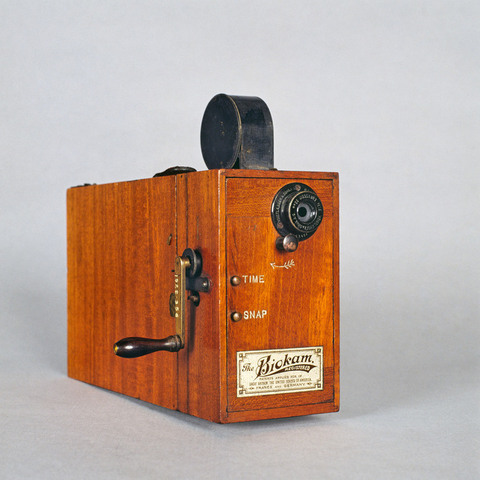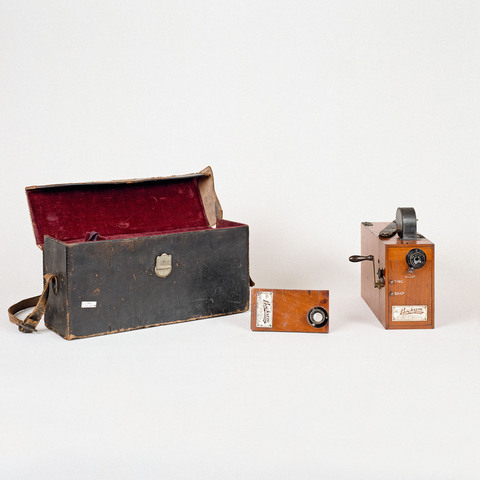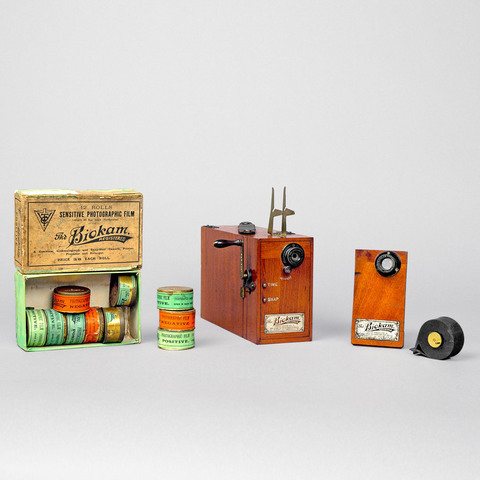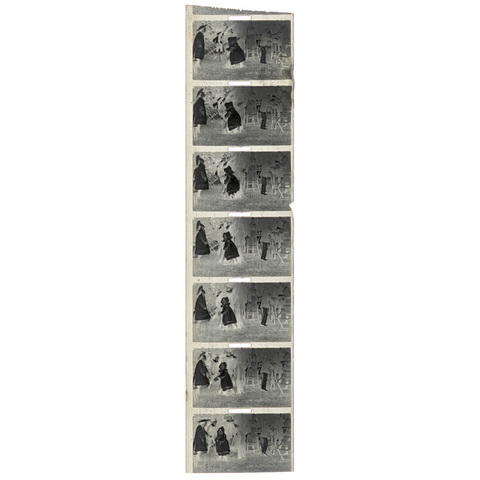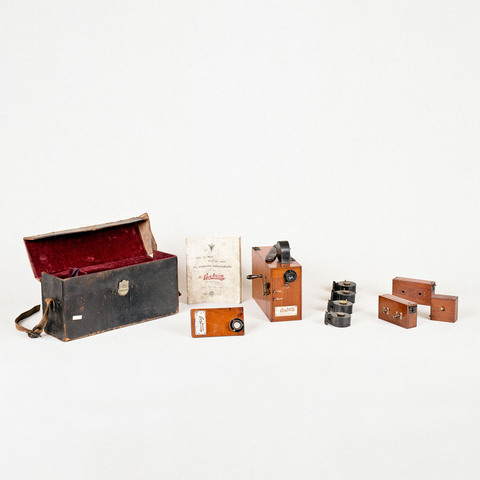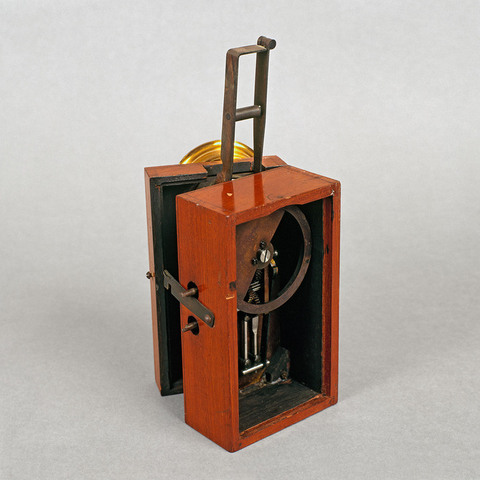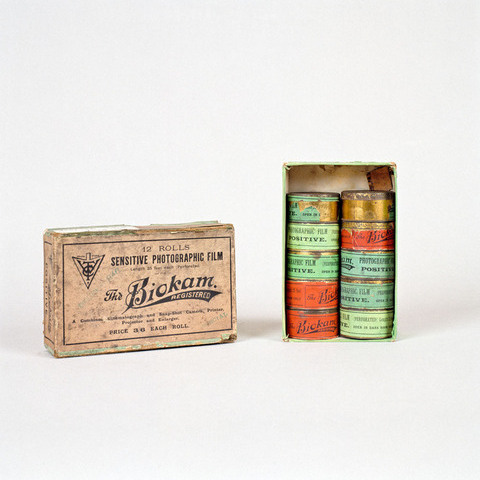Caméra réversible film 17,5 mm
Fiche détaillée
Type de l'appareil
entraînement du film 17,5 mm à perforation centrale par une griffe ; came excentrique et bielle ; obturateur une pale ; manivelle ; poignée
Auteurs
Wrench Alfred
Londres, 39 Grays Inn Road
Darling Alfred
Brighton, 47 Chester Terrace
Fabricants
Alfred Darling
Brighton, 47 Chester Terrace
Voigtländer & Sohn
Braunschweig
Utilisateurs
Wrench Alfred
Londres, 39 Grays Inn Road
Darling Alfred
Brighton, 47 Chester Terrace
Distributeurs
Warwick Trading Company
Londres, Wardour Street
John Wrench
Londres, 50 Gray's Inn Road
Elie Xavier Mazo
Paris, 8 boulevard Magenta
Sujet du modèle
Informations non disponibles
Objectif
Voigtländer & Sohn, Brunswick, Euryscop 38 mm f. 7,7 (prise de vues) et Voigtländer n° 4824 (pour projection)
Taille de l'objet
Ouvert :
Informations non disponibles
Fermé :
Longueur : 34 cm
Largeur : 11 cm
Hauteur : 15.5 cm
Diamètre :
Informations non disponibles
Taille de la boîte de transport
Informations non disponibles
Remarques
Collection Will Day. Plaques conservées sur les deux faces avant avec objectif de projection et de prise de vues : "The Biokam registered. Patents applied in Great Britain, the United States of America, France and Germany".
Le Biokam sert à la prise de vues cinématographiques et photographiques, au tirage, à la projection. Le premier modèle apparaît vers juillet 1899 en Grande-Bretagne, il est en bois d'ébène. Peu après sort le modèle en acajou verni. La Warwick Trading Company et John Wrench le proposent dans leurs catalogues mais le fabricant, selon John Barnes, est Alfred Darling. De nombreux films furent édités en format 17,5 mm pour le Biokam : film de Georges Méliès, George Smith, etc. Il existe aussi des films d'amateurs, dont quelques uns conservés par Will Day. Le Biokam, "a combined Cinematograph and Snapshot Camera, Printer, Projector, Enlarger and Reverser, fitted with two special Voigtlaender Lenses, finished in Polished Ebony" coûte 6,60 livres sterling en 1899.
"Animated Photography for Amateurs. The Biokam registered (patented in all countries). A combined Cinematograph and snap-shot camera, printer, projector, reverser, and enlarger. Fitted with two special Voigtlander lenses. Price : £6, 6 s. The Biokam projector, for projecting, reversing and enlarging only. Fitted with adapter to screw into lens flange of any existing lantern. Price £ 4, 4 s. Sensitive film, positive or negative, perforated (length 25 ft.), 3/6 each. Biokam film subjects, 25 ft. full length, price 10 each. Same duration of exhibit as films used for public cinematograph entertainments. For sale by all opticians and photographic dealers, The Warwick Trading Co., Ltd., 4 & 5 Warwick Court, High Holborn, London W.C." (Henry Hopwood, Living Pictures, Londres, Optician & Photographic Trades Review, 1899, p. 185, p. XIII).
"Ce remarquable appareil s'appelle le Biokam, dont la signification littéraire est une chambre noire vivante. [...] Le Biokam peut projeter les images sur un écran de 1,80 m2. [...] Il exige très peu de connaissances spéciales pour obtenir des épreuves, pour développer et imprimer les bandes de pellicules et pour les projeter sur un écran. [...] La Compagnie fournit des rouleaux de pellicules préparées pour l'emploi. Elles peuvent être développées et utilisées avec le cinématographe. Il est donc facile aujourd'hui pour l'amateur de se livrer à ce nouveau genre de photographie. [...] Il est difficile de s'imaginer à quel degré cette nouvelle forme de photographie viendra affecter notre vie de tous les jours. [...] Agent pour la France : E. Mazo, 8 & 10 boulevard Magenta, Paris" (Le Photogramme, vol. 3, n° 8, août 1899, p. 145.)
"The Biokam consists essentially of three principal parts, each of which is quite distinct. Firstly there is the mechanism chamber, in which the actual photography is accomplished, and which carries the lens and the shutter, besides the mechanical contrivance for actuating the film. Secondly there is the box or spool holder in which the unexposer film is stored ; and thirdly there is the chamber into which the film finds the way as it leaves the camera proper. The receptacle for the exposed film is normally attached to the mechanism portion, and the two together form one, apparently inseparable, instrument. The box containg the unused film is attachable to the top of the camera. This box for containg the unexposed film [...] is a circular box, made of blackened brass, something of the shape of a large pill box, except that there is a shute or outlet for the film springing tangentially from its edge. Running through the centre of the box is a spindle which may be turned by means of a little crank handle on the outside. The shute is so shaped as to be attachable to the camera by a special contrivance making a light-tight joint. After the film passes through the camera proper it is not re-wound upon another spool, because all the contrivances for doing this are found in pratice to be very uncertain and inefficient in their action. It has been found better to simply allow the exposed film to coil up in a light box. This film receptable is made double, like a double darkside, so that after one exposure has been made the box is simply reversed, and then another film may be run into it. [...] The camera itself, with the cinematograph mechanism, is normally attached to the front of this larger film receptacle, with which it forms a complete whole. The inward parts of the camera mechanism, though not of an unnecessarily complex character, are, as may he supposed, not so simple as to understood at a glance. With the actual works however, we are not here concerned, for they are necessarily of a somewhat delicate nature, and should not be tampered with except by an expert in mechanical contrivances of the kind. But the design is so perfect, and the workmanship so excellent, that there is little chance of any derangement. It is necessary to remember the function of this mechanical portion of the instrument. It has merely to draw the film down through the camera, at the intervals between the exposures, so as to present a fresh portion to the action of the light coming through the lens. It leaves the film perfectly stationary between there periods of movement, and while the film is at rest it opens the shutter over the lens and impresses a photograph upon the sensitive surface. In the case of animated photographs, this occurs about twenty times in a second" (How to make, how to show an Animated Photograph by means of the Biokam, London, [Warwick Trading Company], s.d., p. 4-5)
"The word Biokam therefore literally means a "Living Camera". [...] The Biokam is a portable instrument for the use of amateur photographers for the production of series-negatives for the cinematograph. It is a printing machine whereby any desired number of photographic positives may be made from these negatives. Its is a projection cinematograph by means of which these Living photographs, taken by the amateur himself, or others which are easily obtainable, may be thrown upon a lantern screen for his delectation and that of his friends. It is a very convenient form of Hand camera for the production of an almost unlimited number of midget portraits or photographs of any description with the minimum of troubles - photographs which may be printed upon paper in the usual way or thrown upon the lantern screen in the form of lantern slides. It is an optical lantern, with the aid of which these little photographs may be enlarged to a considerable size upon the screen [...] The photographic lens is of the well-known Voigtlander Euryscope patteren which, as photographers know, is rectilinear abd symmetrical. It gives very accurate definition without a trace of distortion, and that at so large an aperture that it is capable of very rapid work. It has a fixed stop and works at F. 7.7 and its focus is 1 1/2 inches" (The Biokam, patented in all countries, London, The Warwick Trading Company, s.d.).
Bibliographie
Henry Hopwood, Living Pictures, Londres, Optician & Photographic Trades Review, 1899, p. 185, p. XIII.
Cecil M. Hepworth, Animated Photography, The ABC of Cinematograph, London, Hazell, Watson & Viney, 1900, p. 124-125.
How to make, how to show an Animated Photograph by means of the Biokam, London, [Warwick Trading Company], s.d.
The Biokam, patented in all countries, London, The Warwick Trading Company, s.d.
Blue Book of Warwick and Star Selected Film Subjects for Standard American Gauge Animated Picture Apparatus, London, Warwick Trading Company, s.d.
Le Photogramme, vol. 3, n° 8, août 1899, p. 145.
Kenneth F. Miller, "A Sub-Standard Pioneer", Home Movies & Home Talkies, London, October 1936, p. 189.
John Barnes, Filming the Boer War, Londres, Bishopsgate Press, 1992, pp. 170-185.
